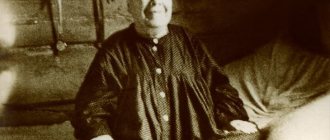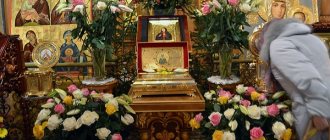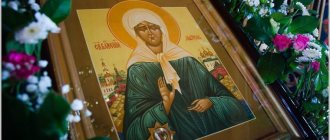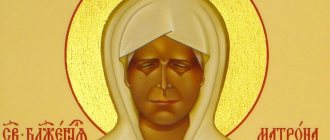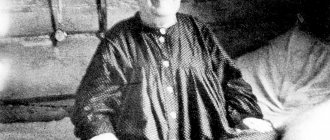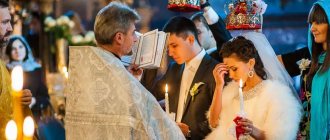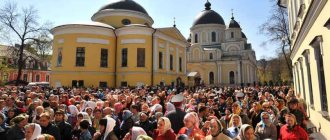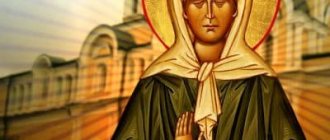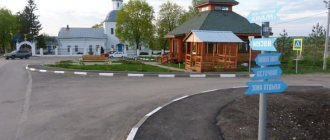Unwanted child
Yuri Alexandrovich Olsufiev. Photo from the investigation file. 1937
In psychology, popular these days both among secular people and among believers, it is not unreasonable to look for the roots of many of a person’s life problems in his childhood and even in intrauterine development. According to this approach, little Matryusha would have to grow up with serious claims both to life and to God: no one wanted her birth. Matrona's mother, Natalya Nikonova, became pregnant with her in adulthood. The poor peasant family already had three children: a daughter, Maria, and two sons, Mikhail and Ivan. The Nikonovs lived in the village of Sebino, Tula province, not far from the famous Kulikovo Field, and at a short distance from them, a local landowner, Count Yuri Aleksandrovich Olsufiev, organized an orphanage for 40 places. It was decided to send the unborn fourth child there - due to the banal impossibility of feeding the baby...
Matrona was born in 1885 (according to other sources - in 1881). Shortly before the appearance
Sofya Olsufieva. Photo from the 1930s.
Natalia Nikonova, her daughter, had a dream: a white bird with a human face and tightly closed eyelids landed on her shoulder. The woman, remembering this dream, took it as a sign and changed her mind about giving the child away. And the more I became convinced that the dream was not empty when I saw my newborn daughter: the girl was born with a developmental defect, anophthalmia: the eyeballs were absent or were extremely underdeveloped, the eyelids were closed.
In life, many things are intricately intertwined, and it is worth mentioning the shelter, which almost became the future blessed home. This shelter was organized by Count Yuri Aleksandrovich Olsufiev and his wife, Sofya Vladimirovna. A God-fearing and active man, whose confessor was the Optina elder Anatoly (Potapov), Yuri Alexandrovich also supervised the construction of a monument church in honor of Sergius of Radonezh right there on the Kulikovo Field, and during the years of Soviet power he saved the Trinity-Sergius Lavra from plunder. In 1938, his life was cut short at the Butovo shooting range, and Yuri Alexandrovich’s wife, Sofya Vladimirovna, died five years later in custody, in the Sviyazhsky monastery...
First miracles
Matrona will face the horrors of Soviet power later, but now she is a simple little blind girl. Only during the sacrament of Baptism was performed on her did it become clear that, after all, she was not simple. This is how the elder of the Church of the Assumption, where the future blessed one was baptized, Pavel Ivanovich Prokhorov, recalled it: “Two days before the christening, the priest Fr. Vasily is from the village of Boryatino, which is 5 km from the village of Sebino. It was on the eve of some holiday. It was this priest who baptized Matryushenka. When, during baptism, the priest dipped her into the font, a column or steam, or light fragrant smoke rose from the font to the ceiling, I don’t remember exactly. The priest was extremely surprised, saying: “I have baptized babies a lot, but this is the first time I have seen this, and this baby will be holy.”
Prayer to Matrona of Moscow for help
Oh, blessed mother Matrona, we resort to your intercession and tearfully pray to you. As you who have great boldness in the Lord, pour out a warm prayer for your servants, who are in deep spiritual sorrow and asking for help from you. Truly is the word of the Lord: ask, and it will be given to you, and again: even if two of you take counsel upon the earth, whatever you ask, it will be given to you from My Father who is in Heaven. Hear our groanings and convey them to the throne of the Master, and where you stand before God, the prayer of a righteous man can do much before God. May the Lord not completely forget us, but look down from the heights of heaven on the sorrow of His servants and bestow the fruit of the womb for something useful. Truly, God wants, so do the Lord to Abraham and Sarah, Zechariah and Elizabeth, Joachim and Anna, pray with him. May the Lord God do this to us, out of His mercy and ineffable love for mankind. Blessed be the name of the Lord from now on and forever. Amen
First trip and move to Moscow
At the age of 14, Matrona left her village: the daughter of a landowner who lived next door, Lydia Yankova, took her on the first and only big trip in her life. The pilgrims visited the Kiev-Pechersk Lavra, the Trinity-Sergius Lavra and, according to legend, in Kronstadt, where the righteous John of Kronstadt himself called the little blind teenager to him: “Come, come to me, Matronushka. My shift is coming...”
And at the age of 17, the girl lost her legs. From then on, the blessed one received people sitting. And then for the first time she began to talk about the coming terrible days: “They will rob, destroy churches and drive everyone away”... But, it seemed, no one took her words as a close prophecy: it will happen, maybe, but it’s unlikely to happen to us.
The village of Sebino, the birthplace of Blessed Matrona
For her, persecution began from her home: both brothers, who joined the party, could not tolerate the blessed sister next to them, to whom people were coming in a line. In 1925, Matrona moved to Moscow and lived there until the end of her days. It’s hard to say “lived” - she wandered through basements, sheds, and apartments, where she couldn’t stay for long, so as not to set the owners up. On Ulyanovskaya Street, on Pyatnitskaya, in Sokolniki, in Vishnyakovsky Lane, at the Nikitsky Gate, in Petrovsko-Razumovsky, in Tsaritsyn, and finally, in Starokonyushenny Lane. And more than once she managed to return to her native village to visit her elderly parents.
Many times she miraculously avoided arrest: she left just minutes before the police arrived. One day, the “servant of order” nevertheless tracked down the blind old woman, came victoriously to pick him up and heard from her: “Run quickly, there is misfortune in your house! But the blind woman can’t get away from you, I sit on the bed, I don’t go anywhere.” He obeyed, went home and found his wife there, burned from the blaze of kerogas - he managed to take her to the hospital, everything ended well. The blind woman really didn’t go anywhere, but the next day, when she came to work, the policeman flatly refused to take her away.
Like a child…
Years go by, and before us is already a mature woman. We know her from rare photographs, in the most famous of which Matrona sits on the bed, placing her small plump hands on her knees, sitting with a completely genuine, ingenuous smile on her face. What is she like now?
There is one story that can convey this.
A brother and sister came from a village in the Tula region, neighboring Sebino, to sell a cow in Zhavoronki, near Moscow. And on the way they lost documents: both their personal ones and those for the cow... My brother panicked: “They’ll find me without documents, they’ll think that the cow was stolen!” Now you can’t spoil it, there’s an armed patrol all around. That's it, there's no shame! I'll hang myself! I’ll hang myself!” - “Oh, you fool, you fool! Shame on you to say this! Let’s ask Matronushka - maybe she’ll help,” said the sister. “How can it help if she herself is sitting on a bed somewhere in Moscow, blind from birth?”
But still they asked...
Icon of the Mother of God “Seeking the Lost”, painted at the request of Blessed Matrona
It took 10 days to get to Moscow and found lodgings everywhere, although who is interested in letting strangers home in bad times, especially without documents, and even with a cow on a leash. One day, a patrol arrived at the hut where the brother and sister were staying. But the owners somehow unexpectedly began to shield the guests: “We’re all our own.” They reached the place safely, sold the cow and, on their way back, decided to call on Matrona. The blessed one appeared to them like this: sitting on a high bed, in a blue dress, her hair combed on both sides, her legs dangling like a small child, and she was laughing. Those who came didn’t even have time to open their mouths, but she told them:
- Well, you gave me a job! The cow led them by the tail all the way! Here, take them a cow, and also show them where good people live, where they will let you spend the night.
And when they said goodbye, Matrona turned to her brother and could hardly contain her laughter.
- How did it happen, Vanya, that your sister, who is younger than you, called you a fool? Oh no no no! “And she continued while poor Vanya froze with his mouth open in surprise: “You can straighten your passport for ten rubles... “I’ll hang myself!” I’ll hang myself!” - he imitates the guy in a kind way. - Don't say such nonsense again! — And she shook her little finger.
Perhaps this is a portrait. Perhaps that’s why “Matronushka” is there: a small woman, with small chubby hands, like a baby’s, and a touching smile on her face - there is not a single photo where she is not smiling.
Terrible years
Matrona’s life in Moscow came at the most terrible time: the end of the Civil War, poverty, hunger, the Yezhovshchina - the terrible years of 1937-1938, when people disappeared, an atmosphere of fear and denunciation reigned everywhere, and then the war came. A huge sea of human grief. And people reached out for consolation and hope, for healing of soul and body. They testify that God often revealed to Matrona the fates of those fighting at the front; through her prayers, those who were considered missing returned. To one woman, who received a “funeral” for her husband three times, the blessed one said: “Alive, he will come to Kazanskaya, knock on the window,” and indeed, the husband returned in 1947.
Moscow. Starokonyushenny lane no. 30. 1929 Here, in the Zhdanov family, Blessed Matrona lived from 1942 to 1949.
She told people words that in no way contradict Christianity: believe that God exists and by His power everything will be settled; wear a cross, pray, take communion more often, don’t believe dreams, never lose hope, learn to control yourself. She did not teach, she pitied people, stroked them on the head, gave specific advice in specific situations, often with humor, always with joy. She advised those who were sick to take communion more often, and the illness - even a serious one, be it tuberculosis or epilepsy - would recede. “We must control ourselves, endure”; “The Lord himself will manage everything!”; “Pray, ask, repent! The Lord will not leave you and will preserve our land.”
And wonderful things happened - these stories can be told endlessly - and the flow of visitors did not dry up.
Much evidence of the saint’s help has been preserved, but less is known about her and the details of her life in the capital than about her affairs. In fact, her whole life boiled down to prayer and helping people. Those who knew her during her lifetime recalled that Matrona even had a hole on her forehead from the constant sign of the cross: the old woman prayed at night.
The grave of Blessed Matrona at the Danilovsky cemetery. 1952
The blessed one lived a difficult life and died quietly on May 2, 1952. She knew about her impending death and was worried about how to properly fold the arms in the coffin. When the priest who came to confess and give her communion, surprised by this, asked: “Are you really afraid of death?” “I’m afraid,” the blessed one answered ingenuously. And she asked to be buried at the Danilovsky cemetery, near the temple - “so that she could hear the service.” Her funeral service was held in the Church of the Laying of the Robe of the Lord on Donskaya Street by priest Nikolai Golubtsov. On May 4, the day of the Myrrh-Bearing Women, with a large crowd of people, the blessed one was buried at the Danilovsky cemetery, next to one of the few churches operating at that time.
On May 1, 1998, with the blessing of Patriarch Alexy II, the honorable remains of the old woman were transferred to the Pokrovsky Stauropegic Convent on Taganskaya Street, where they remain to this day. Blessed Matrona was canonized as a locally revered Moscow saint in 1999, and five years later her church-wide canonization took place. In 2013, the Holy Synod established an additional (in addition to May 2) day of remembrance of the blessed one, in memory of the discovery of her venerable relics - March 8 (according to New Art).
When do they call on the righteous?
Contemporaries recalled that the saint did not ignore any request. Coming to her, any person could count on wise advice. Therefore, prayer to the Holy Matrona of Moscow will protect you from all disasters - natural disasters, slander, deceptions, illnesses and conflicts, will tell you the right path, promote spiritual insight, give love, meekness and humility.
And a personalized amber icon of the Matrona of Moscow, on which the righteous woman is depicted, will be a desired gift for every Christian, protecting against sins, temptations, wicked thoughts, leading to salvation and eternal life!
"Women's Fables"
Unfortunately, in the current veneration of Blessed Matrona there are things that partially or completely contradict the Orthodox worldview.
Matrona Dimitrievna Nikonova. Photo 1930-1940
Having opened the first unofficial life of Matrona - “The Tale of Matrona” by Zinaida Zhdanova - we will hear stories that grate the ear of a Christian, for example, about the blasphemous advice according to which vomiting after Communion is good: demons, they say, come out this way, but “they penetrate a person with the air when breathing, they live in the blood.” The fact that the people asked the blessed one to “read prayers over them”, “read over water”, which echoes the practice used by sorcerers. About the fact that the blessed one allegedly asked to close the windows and vents on the days of demonstrations so that hordes of demons would not enter the room... Finally, about how she exalted herself, allegedly revealing to Zinaida Zhdanova, the author of the life, in a dream that she had regalia and awards from Gentlemen.
“Zhdanova’s book contains too many statements offensive to Christian ears that are heard on behalf of Matrona. And until it is proven that Matrona herself did not say these words, I will pass by her icons...” writes a participant in one of the online discussions. And how can I blame him? How can one be surprised that in the popular consciousness, after such stories, the name of the blessed Matrona is closely intertwined with the name of the Bulgarian sorceress Vanga?
Firstly, Zinaida Zhdanova’s book - the first unofficial life of Blessed Matrona, which had enormous success in its time - was examined by the Synodal Commission for the Canonization of Saints and subjected to severe criticism. The Church did not recommend her as a source of information about Saint Matrona, despite the fact that Zhdanova personally knew the old woman. Subsequently, the author herself admitted that there was a lot in this book that she invented...
The commission was guided by another version of the life - “The Life of the Righteous Matrona, Blessed Elder of Moscow . And in particular, in this text you can find the following words: “The help that Matrona gave to the sick not only had nothing to do with conspiracies, divination, so-called folk healing, extrasensory perception, magic and other witchcraft actions, in the performance of which the “healer” is associated with dark power, but had a fundamentally different, Christian nature. That is why the righteous Matrona was so hated by sorcerers and various occultists (this is evidenced by people who knew her closely during the Moscow period of her life). First of all, Matrona prayed for people. Being a saint of God, richly endowed with spiritual gifts from above, she asked the Lord for miraculous help for the sick. The history of the Orthodox Church knows many such examples <…> Matrona read a prayer over the water <…> We do not know the content of these prayers, but, of course, there could be no question of the consecration of water according to the rite established by the Church, to which they have a canonical right only clergy. But it is also known that <…> the water of some reservoirs, springs, wells, marked by the presence and prayer life of holy people near them, has beneficial healing properties.”
Secondly, alas, it is impossible to disown the time in which the blessed one lived. It’s no secret that both witchcraft and ritual belief flourished in the villages. One elderly resident of Izhevsk, who moved to the city from the village, told how his relative, an old witch, could not die, whose witch’s “gift” was not accepted by either her daughter or her granddaughter - and, without passing on her knowledge, according to popular belief, the witch did not may die. How the villagers dismantled the roof and performed other actions so that the soul of the unfortunate old woman could be freed from the body. Such stories - it would seem in atheistic times - were almost commonplace in villages and, together with the residents, migrated to Soviet cities. In the minds of unenlightened people, fortune telling for Christmas time and the holy holiday of the Nativity of Christ, the “Battle of Psychics” and the television broadcast of the Easter service, prayers and horoscopes are still mixed up - it’s all true!
Therefore, some almost occult moments that can be found in the first “life” of Matrona are still perceived by many as in the order of things.
On the left is Saint Matrona
So, of course, approval of vomiting after communion is unthinkable for a Christian. Even if the priest accidentally spills Communion on the floor, the service stops, and this place in the floor is burned out with fire or cut down - that is how seriously the Church takes the bread and wine transformed into the Body and Blood of the Lord. When the Optina elder Joseph (Litovkin) was asked what to do if a sick woman who received communion at 6 o’clock in the evening vomited after midnight, he answered: “A lot has passed since Communion, and there is nothing reproachful here. However, it wouldn’t be a bad idea to take the plucked items into running water or to a side where there would be no uncleanliness.” This is a reverent attitude, unlike that described by Z. Zhdanova.
Quotes about demons are also an illustration of a completely non-Christian attitude towards dark forces. The Monk Anthony the Great spoke about demons: “If demons were surrounded by the same bodies as we are, then they could say: we do not find people hiding, but we will harm those who are found. Then we could take cover and hide from them by locking the doors. But they are not like that; They can also enter through locked doors.”
The words about rewards from the Lord attributed to Blessed Matrona are yet another testimony contrary to the spirit of Christianity. The Optina elder Macarius wrote about something similar: “From this alone, that the wanderer tells you <...> that “the whole city is supported by his prayers,” one cannot believe his holiness; “We don’t see anywhere in the lives of saints or righteous people preaching about themselves like this, but on the contrary, they considered themselves dust and ashes and unworthy, and the grace of God acted through them.”
Here is another story that is not consistent with the Orthodox worldview, allegedly written down from the words of Blessed Matrona Zinaida Zhdanova. As if on the eve of the siege of Leningrad, soldiers tried to open the tomb of the holy righteous John of Kronstadt, for which he, having rebelled, threatened to “drown in blood and starve” St. Petersburg... “The story about “drowning in blood,” writes church historian Andrei Zaitsev, “completely contradicts how the image of the revered saint, and the entire Christian tradition, but it is strikingly reminiscent of the apocryphal Gospels (rejected by the Church and not included in the New Testament canon). For example, in the “Gospel of the Childhood of Christ” there is a story about how little Jesus, with the help of a miracle, kills a boy who mocked him.” Of course, a person who is well acquainted with the Gospel is able to isolate something alien to him from the “people's lives.” If the acquaintance is superficial, such sad misconceptions and myths arise. As Metropolitan Yuvenaly of Krutitsa and Kolomna, who headed the Commission for the Canonization of Saints from 1989 to 2011, noted, “the canonization of a righteous person does not mean the canonization of every line he wrote.” If such caution applies even to the words of the saints themselves, then even more so to the words of other people about them...
Hagiographic material
Photo from the website pokrov-monastir.ru
The case when at the time of the canonization of a saint his official life had not been compiled is not exceptional; there have been many of them in the history of the Church. After canonization, historians and theologians can compile the life of the ascetic, based on actually existing texts about the saint.
For the life of St. Ambrose of Optina, such a source was the excellent biography of the elder, compiled in 1900 by Archimandrite Agapit (Belovidov); We know about St. Seraphim of Sarov from the “Chronicle of the Seraphim-Diveyevo Monastery,” written by Metropolitan Seraphim (Chichagov), and the notes of Nikolai Motovilov.
But how did it happen that Zinaida Zhdanova, a simple Russian woman ignorant of Christian dogma, becomes, albeit briefly, the hagiographer of the blessed one?
The difficulty here lies in the very concept of a canonical hagiographic text, the writing of which has its own specifics. Lives are divided into two large groups: martyrs and venerables. In the first case, the hagiographic text is based on the court record of the interrogation of the martyr, and the central place in the narrative is occupied by the description of suffering for Christ.
From the ancient martyrias (protocols, testimonies), the reader could not learn anything about the life of the saint until the last days of his life and his martyrdom. They are brief, but almost always historically accurate.
The classic life of a monk goes back to the ancient genre of biographies and is a more or less complete story about the life of an ascetic, which can begin before the moment of his birth (with predictions about his birth) and end with a description of the posthumous miracles of the saint.
Depending on the amount of information about the saint and the time that elapsed from the moment of his death until the writing of the hagiographic text, as well as on the competence of the compiler, the life could be detailed and reliable (like the life of St. Theodosius of Pechersk), or it could consist of a very meager biographical outline with an abundance unrelated stories about the miracles of the righteous man, his lifetime and posthumous help, a large number of folklore elements, historically unreliable information (as in the case of one of the versions of the life of the first Russian saints Boris and Gleb, written by the monk Jacob Chernorizets, or the folk version of the life of Sts. Peter and Fevronia of Murom).
The Canonization Commission can consider all versions of texts about the saint as “hagiographic material”, but is obliged to give its assessment. Folk Lives are not prohibited, but receive the status of apocrypha
(a work not recognized by the Church as a reliable historical and theological source of information about the saint), as happened with “The Tale of Peter and Fevronia” or “The Tale of Boris and Gleb” in the version of Jacob Chernorizets.
If the text proposed as a life raises doubts, the commission conducts an investigation and makes its judgment - which is what happened in the case of the life of the blessed Matrona of Moscow as edited by Z. Zhdanova. In the act of canonization of St. Matrona, signed by Patriarch Alexy II, a separate paragraph indicated the need to compile the life of the ascetic, which emphasizes the Church’s non-recognition of the version of the “life” of St. Matrona, written by Z. Zhdanova.
Queue
Pokrovsky Convent, 15th anniversary of the canonization of Matrona of Moscow. Photo by the press service of the Patriarch of Moscow and All Rus'. 2014
Even the 13th century preacher, Bishop Serapion of Vladimir, denounced some believers (or those who call themselves such) that they strive more for miracles, sorcerers and healings with the help of “water”, “strawberries” than for Communion and prayer... And modern priests are in pain They say: “On Epiphany, on the “honeyed” Savior, on Palm Sunday - the church is packed, there’s nowhere for an apple to fall. People are jostling, rushing to bless honey, apples, willows, to collect more holy water <...>, while Christ offers every day at the liturgy something incommensurably greater - Himself. Give us some honey and some water!..."
Therefore, it happens that a person savvy in matters of church teaching has a hard time getting in line at the Intercession Monastery, where one can hear so many conversations about which foot is the right one to approach the relics of the blessed one, and about removing the evil eye with the help of an icon, and much more “ amazing" things.
But is it worthy to blame people who stand here at any time of the year? Don’t they also take upon themselves an intuitive feat, without which it is difficult to imagine Christianity? A small contribution, transformed into labor - to come here, freeze in line or, conversely, suffocate from the heat, next to those whom God will send... This string, this line of human grief stretches for centuries, millennia. And no matter how enlightened we may seem to ourselves, knowing that Christianity is primarily about Christ, do we have the right to mock those who stand here in despair and horror before the blows of life?
“Icy rain, a piercing wind, a line of people goes around the temple... I’m dressed in light demi-season shoes, with a raincoat on my shoulders. And there are many of them, naked like me... I trample, I pray, I ask you to give health to my mother. Two hours passed. The cold sent a burning pain all over my body from my knees. And then I understand, that’s it... I can’t do it anymore. “Lord, have mercy, give me strength!” Another hour passed, the cold shackled the diaphragm, the feeling that the lungs were stopping breathing. I call my sister, cry, complain, ask for support in my decision to leave, I have no more strength. My sister listens, she feels very sorry for her beloved sister, she sobs with me, but remains silent. She understands, this is for mom’s sake... for mommy’s sake...” This is the story of Elena Alexandrova (Elena Alexandrova. Mom and Mother. - Pravoslavie.ru website), one of the women in the queue, one of thousands. And my mother’s health, by the way, has improved...
What words could describe the difficult and righteous life of Blessed Matrona, and this line, and hundreds and hundreds of stories of gratitude from people for the help received through the prayers of the saint? Perhaps these? Come to Me, all you who labor and are heavy laden, and I will give you rest (Matthew 11:28).
What did the blessed one want to say?
Photo from the site glavtema.ru
Language, the way of communication of the blessed with people is often metaphorical and figurative. St. Basil threw stones at the walls of the temple and hugged the corners of the whorehouse (house of brothel), leading the Orthodox into temptation. But the saint explained that a demon looked into the temple and he drove it away, and an angel cried at the brothel and he sympathized with him so much.
How to understand the “difficult passages” of the life of St. Matrons? The editorial approach of the canonical version offered an allegorical explanation in the spirit of patristic thought. For example:
From the first edition of the life of Z. Zhdanova: “During the days of demonstrations, Mother asked us all not to go out, to close the windows, vents, doors. Hordes of demons occupied all space, all air and embraced all people. She taught us not to forget to baptize food, and especially to clean and cover everything at night, because demons swarm around, penetrating everywhere. By the power of the Honest and Life-Giving Cross, save yourself and defend yourself.”
From the canonical life: “On the days of demonstrations, mother asked everyone not to go out into the street, to close windows, vents, doors - hordes of demons occupy all the space, all the air and embrace all people. (Perhaps Blessed Matrona, who often spoke allegorically, wanted to remind us of the need to keep the “windows of the soul” closed from the spirits of evil - that’s what the Holy Fathers call human feelings. And windows for demons are not an obstacle.).”
We see that the compilers of the canonical version of the life tried to explain the folk etymology that Zhdanova used (the consonance of the words demonstration and demon, in the absence of real family ties between them), by interpreting the words of the ascetic in accordance with the patristic tradition.
